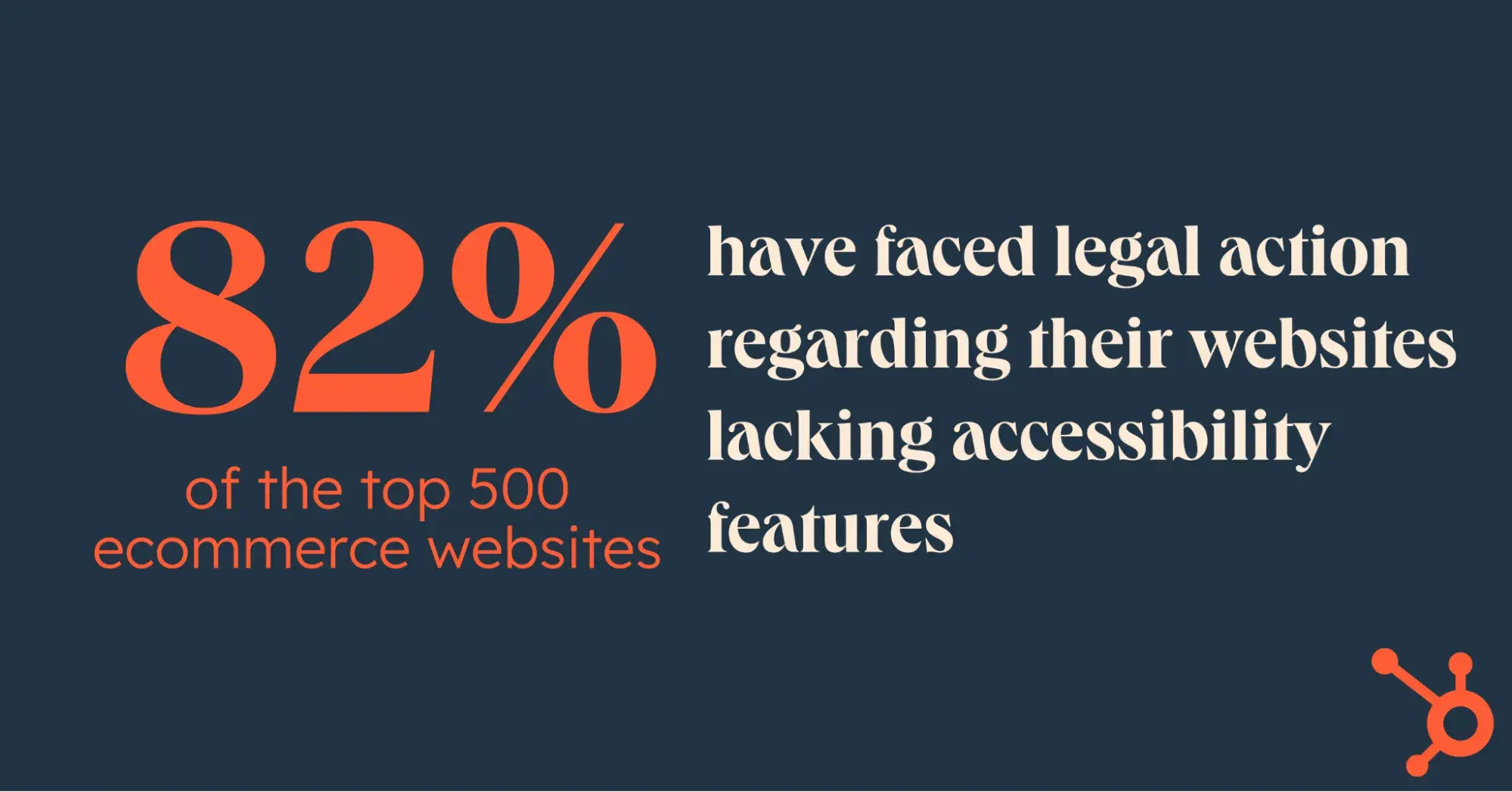Did you know that almost two billion people worldwide need accessibility features such as alt text, captions, contrasting colors, and more to navigate a website? As a business and website owner myself, I don’t want my website to be inaccessible, and I don’t want to miss out on the potential revenue that a bigger audience would bring.
In an effort to make websites more accessible, lawsuits against businesses that don’t take preemptive measures have been on the rise. Below, I’ll cover a few important accessibility lawsuits you should know about and what we can learn from them.
Note: This blog post is not legal advice. If you are facing an accessibility lawsuit, please reach out to a legal professional for advice.
Table of Contents
- What Is a Web Accessibility Lawsuit?
- Quick Accessibility Lawsuit Stats to Know
- Five U.S. Web Accessibility Lawsuits That Show the Importance of Accessibility
What Is a Web Accessibility Lawsuit?
A web accessibility lawsuit is a lawsuit against a business that runs an ecommerce website that does not comply with the ADA (the Americans with Disabilities Act).
The ADA prohibits discrimination against those with disabilities. A famous lawsuit against Winn Dixie (which I’ll cover more below) established that businesses must-have features to help the blind, deaf, and others with disabilities be able to shop at online stores.
Yet, making your ecommerce website more accessible can mean more than just avoiding a lawsuit. Those with disabilities have a buying power of nearly half a trillion dollars.
But more than that, it’s the right thing to do and the right way to treat your customers. I think Tim Berners Lee, best known as the inventor of the World Wide Web, said it best when he said, “The power of the web is in its universality. Access by everyone regardless of disability is an essential aspect.”
Pro tip: A great way to check your site for accessibility issues is with a Web Accessibility Checklist.
Quick Accessibility Lawsuit Stats to Know
I’ve found there are lots of compelling statistics that show just how widespread accessibility lawsuits have become. Here are some that might urge you to make your website more accessible:
- 82% of the top 500 ecommerce websites have faced legal action regarding their websites lacking accessibility features. It makes sense that top ecommerce webpages would be under more scrutiny and, therefore, more likely to face legal action.
- 97% of accessibility lawsuits target websites and ecommerce businesses instead of brick-and-mortar stores. Brick-and-mortar stores have become less popular in the ecommerce age, and most stores follow strict local and state laws to be accessible.
- Did you know that a lot of those who have disabilities favor the standards set out in the WCAG (Web Content Accessibility Guidelines) rather than just generic accessibility overlays on websites? In fact, 30% of lawsuits involve websites that use overlays. To learn more about the WCAG, check out their website here.
- Accessibility lawsuits tend to be very successful. This means it’s always better to have your website meet accessibility standards before potential litigation. Check out the Ultimate Guide to Web Accessibility to get started.

Five U.S. Web Accessibility Lawsuits That Show the Importance of Accessibility
PUNTED GIL v. WINN DIXIE
Case Description
This case was one of the first accessibility cases of its kind. In 2017, Gil sued the grocery chain store Winn Dixie because their website wasn’t accessible to the blind. He bought his groceries and prescriptions on their website but couldn’t operate it as a blind man.
The Outcome
The judge ruled that because Winn Dixie’s website was so integrated with the physical store locations, its website must meet accessibility requirements as well. While Gil did not receive damages, his lawyer’s fees were paid for by the defendant, and Winn Dixie was required to set aside $250,000 to make their website accessible to those with disabilities.
Why This Case Matters
This case was foundational for all accessibility cases that came after regarding business website accessibility. Experts believe that it was the first trial regarding website accessibility and led to the ADA creating online accessibility standards.
.png)
Website Accessibility Checklist
This checklist will help you make the following more accessible on your website:
- Web Pages
- Navigation
- Video & Media
- And More!
Download Free
All fields are required.
.png)
CRYSTAL REDICK v. GENDARME COLOGNE FOR MEN, INC.
Case Description
On April 12, 2022, Crystal Redick filed a complaint in California against GENDARME COLOGNE FOR MEN, INC. Plaintiff CRYSTAL REDICK alleged that www.gendarme.com is not sufficiently digitally accessible. To respond to the claim and to have an adequate ADA plan in place, Gendarme partnered with an accessibility software company (AudioEye) to make their website more accessible.
The Outcome
The plaintiff sued for a $15,000 settlement. Because Gendarme worked with a third-party company, they were able to identify that the claim was a false positive for inaccessibility, and the case was dismissed.
Why This Case Matters
Being hit with an accessibility lawsuit can be highly stressful for companies that don’t know where to begin. Choosing a reputable third-party vendor to step in and make your website more accessible can be a great way to mitigate the impending charges. While it’s better to take steps to be more accessible now, it’s never too late to make your website more ADA-compliant.
ROBLES v. DOMINO’S SETTLEMENT
Case Description
On June 6, 2022, Domino’s Pizza, LLC, settled with plaintiff Guillermo Robles, who suffers from a vision disability. Robles’ legal team specifically pointed out that Domion’s website didn’t have alt text for images and graphics. That included empty hyperlinks without identifying text to describe the link’s purpose and redundant links that led to the same URL address.
The Outcome
The case took six years to complete and resulted in Robles reaching an unknown settlement amount with Domino’s. The Ninth Circuit found that:
“Robles does not seek to impose liability based on Domino’s failure to comply with WCAG 2.0,” the court wrote. “Rather, Robles merely argues — and we agree — that the district court can order compliance with WCAG 2.0 as an equitable remedy if, after discovery, the website and app fail to satisfy the ADA.”
Why This Case Matters
This lawsuit was a great example of why businesses can’t just fight against the ADA to make their case in court. Fighting against the ADA’s restrictions proved to be a huge time and money waste for Domino’s — time and money that could have been spent making their website accessible. Another key takeaway is that a lot of the standards that Robles brought up in their case could have been avoided by complying with the WCAG compliance standard.
TORO v. WHIRPOOL CORPORATION
Case Description
In February 2023, Andrew Toro filed a lawsuit against Whirpool Corp because their lack of accessibility features made it difficult for those with disabilities to shop online, forcing them to spend more time and money by coming in-store if they wanted to purchase. Toro’s legal team argued that this was discriminatory against those with disabilities and didn’t comply with the ADA.
The Outcome
Currently, the case is still in negotiations for a settlement, according to the online case text. The judge, Jennifer L. Rochon, has said that within fifteen days, the parties must submit a joint letter informing the court whether the parties have settled.
Why This Case Matters
This case makes an interesting and unique proposition. If business websites don’t have proper features to make sure they are accessible, they are, in a sense, discriminatory against a group of people. Even if they have in-store availability, like in the case of Whirpool, customers with disabilities must then drive to the nearest store to purchase an item.
BISHOP v. AMAZON
Case Description
In 2018, Cedric Bishop filed a lawsuit against Amazon due to their website lacking screen reading software. Bishop is visually impaired and requires accessibility features on websites in order to make purchases. Bishop sought a permanent injunction that would require Amazon.com to update their website and make it more accessible, as well as financial reparations.
The Outcome
The outcome of this case has not been determined yet, although you could safely assume that Amazon will be told to make accommodations on its website to meet ADA standards.
Why This Case Matters
This case is sometimes referred to as the most “famous” accessibility case of all time. Since the establishment of a legal precedent that ADA requirements apply to websites, there has been an increase in the number of lawsuits filed against companies, including Bishop v. Amazon.
A single customer taking on a giant corporation like Amazon obviously received a lot of media attention. Ultimately, this case shows that no corporation is too large to be taken to court over accessibility concerns.
Making Your Website Accessible To Everyone
I can’t stress how important it is as a business owner to not only make your website accessible but also to consider the online experience those with disabilities have when visiting your website.
As I researched for this article, I was surprised to discover just how universally beloved the WCAG compliance standard is by the disabled community. While it holds website owners to a higher standard than even the ADA, if you can reach WCAG compliance, you can ensure that disabled customers receive the very best online experience.
If your ecommerce website isn’t fully inclusive, there’s no better time to get started on making your website accessible. Take a deep dive into web accessibility and get started.
.png)
Website Accessibility Checklist
This checklist will help you make the following more accessible on your website:
- Web Pages
- Navigation
- Video & Media
- And More!
Download Free
All fields are required.
.png)












